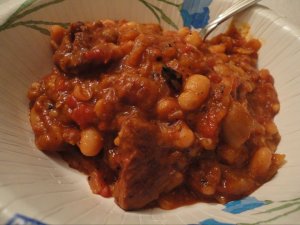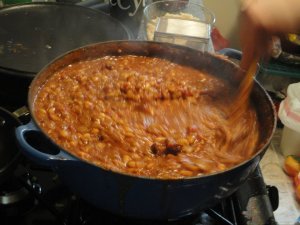My roommate and I had a housewarming party on Friday, and of course I wanted to make sure people had plenty to eat and snack on–with the caveat that it was healthy enough for me to eat too. So I made hummus to serve with veggies, roasted a whole chicken, and baked an apple crisp.
So this sounds basic enough, but I wanted to reinvent the already healthy and relatively low-calorie apple crisp to be low-glycemic and reduce the sugar content. So I grabbed my traditional Better Homes & Gardens Apple Crisp recipe and went to work on changing it.
First, I wanted to eliminate the 1/4 cup white flour in the topping so I replaced it with 1/4 cup almond flour. I also nixed the 1/2 cup brown sugar and replaced it with 1/4 cup agave nectar for sweetness and 1/3 cup wheat bran and 1/4 cup flax-seed meal for texture (and health!). I replaced 4 Tbsp. of butter with 1 Tbsp. olive oil to reduce the overall fat and saturated fat and then added a pinch of kosher salt to make the flavors pop. I added 2 Tbsp. of unsweetened coconut and 1 oz. of chopped almonds for flavor and texture. I kept the rolled oats, even though they are medium-glycemic, because they are fundamental to the texture and taste of my apple crisp. I also added Ceylon Cinnamon to the topping.
For apples, I used half Pink Lady and half Braeburn. I rarely use Granny Smith apples for baking because they have an inconsistent texture depending on age and time of year. One time in college I made apple crisp with all Granny Smiths, and someone asked me if I used applesauce in my apple crisp. Ouch! Since then, I have used a mix of apples and ones that stay firmer during baking. To make the apple crisp faster to make, healthier, more toothsome, and colorful, I don’t peel my apples. Then, instead of adding 2-4 Tbsp. sugar to the apples, I tossed them with 4 packets of Truvia (Splenda would also work) and some Vietnamese cinnamon.
With baking the crisp, I realized that this topping can burn a lot easier than the butter-based version, so the crisp should be checked at 15-20 minutes instead of the 30 minute mark. To help the apples bake in the right amount of time, I cut the apples thinner than I normally do, more of 1/8 inch thick than 1/4 inch like usual. Each 1/8 inch apple wedge was then sliced in half. If the topping is done before the apples are soft, cover with aluminum foil for the rest of the baking.
I loved this apple crisp. The topping had a nuttiness and chewiness to it that was very satisfying. The apples turned out perfectly. And I loved that this dessert was guilt-free!
Nutty Apple Crisp
Special Equipment: Knife, cutting board, casserole dish or pie plate; Time: 20 minutes prep, 20-30 minutes bake at 375°
Serves 4 to 6
Ingredients
For the apple filling:
3 Pink Lady apples, thinly sliced (~1/8 in.); do not peel
3 Braeburn apples, thinly sliced (~1/8 in.); do not peel
4 packets Truvia or Splenda, or to taste
1/2 tsp. Penzeys Vietnamese cinnamon
For the topping:
1/2 cup old-fashioned rolled oats
1/4 cup almond flour
1/3 cup wheat bran
1/4 cup flax-seed meal
1/2 tsp. Penzeys Ceylon or Vietnamese Cinnamon
1/8 tsp. kosher salt
1/4 cup agave nectar
1 Tbsp. olive oil
2 Tbsp. unsweetened shredded coconut
1 oz. almonds, coarsely chopped
1. Place the oven rack in the center of the oven and preheat to 375°.
2. Place the sliced apples in a large mixing bowl and lightly toss with Truvia and cinnamon.
3. Combine the first six topping ingredients together. Add the agave nectar and olive oil and mix til crumbly (you may need to use a fork or your hands for this). Add the coconut and almonds and toss lightly.
4. Place apples in a casserole dish. Add the topping and spread evenly over the apples.
5. Bake in the preheated oven until top is golden brown and apples are soft but not soggy, about 20-30 minutes. If topping is done but apples are not, cover with aluminum foil for the rest of the baking.
6. Serve warm or at room temperature. (Traditionally accompanied with ice cream or whipped cream, though I did not serve either to keep it healthy.)


